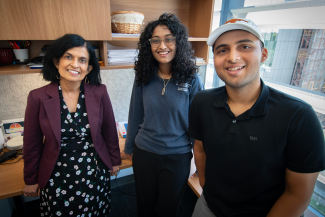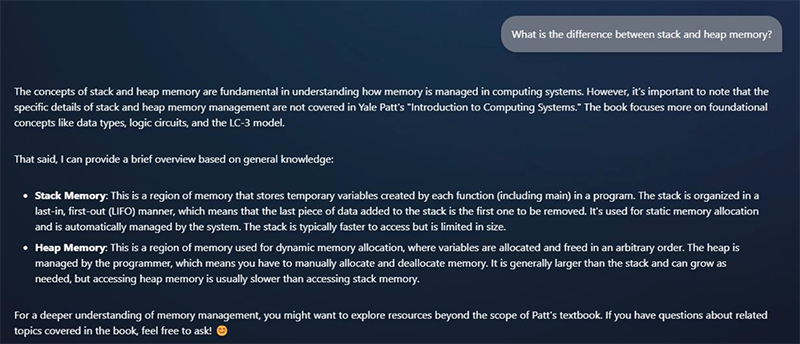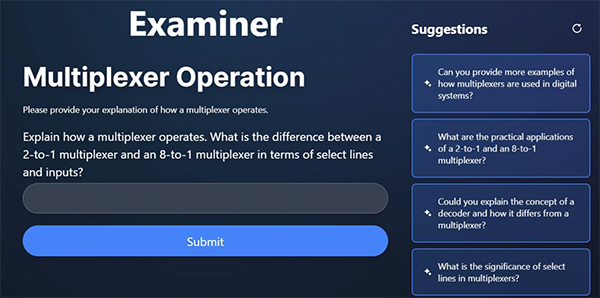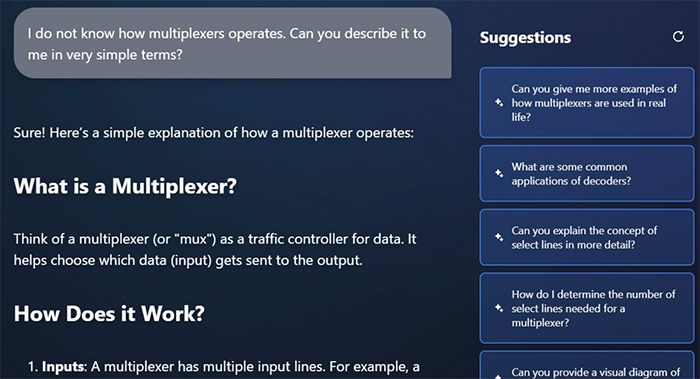
(l-r Prof. Nina Telang, Sneha Ballabh, and BP Rimal)
It’s 11:30 pm, and a student has a question about exactly how a multiplexer works. In the past, this student would have been on their own. But a new AI tutoring program gives electrical and computer students 24-hour, on-demand help to navigate challenges in a key early engineering course.
Educators across the globe are investigating the impacts of generative AI tools on student learning in fields of study such as computer programming, sciences, economics, and medicine. Studies consistently show that these tools have a positive effect, enabling students to receive immediate answers from chatbots while also promoting engagement.
Texas ECE alum and current Texas computer science Master’s student BP Rimal and third-year computer science and electrical and computer engineering student Sneha Ballabh worked with Professor Nina Telang to design and implement an AI-driven virtual tutor that creates personalized learning experiences for first-year engineering students in EE 306, an introductory computing course with nearly 200 students. This foundational course is crucial for computer engineering students, covering topics from computer system fundamentals to assembly language programming.
Rimal approached Prof. Telang about using a platform he co-developed, Genux, which leverages AI to dynamically generate chatbots and their user interfaces. Rimal co-developed GenUX with Uneeb Sajjad (Texas ECE 2023) and Fronrich Puno (Texas CS 2022).
“Our vision was to create a platform where people can build apps driven by AI agents that design the UI in real time,” said Rimal. “These apps should be personalized to each student.”
Prof. Telang had already built an extensive collection of teaching resources, including notes, solved problems, videos, and sample programs. However, she identified self-assessment and personalized tutoring as missing elements that could help students better manage the fast pace of the course.
The system uses course materials from Canvas to generate tailored question banks, offering students a highly personalized learning experience.
“What separates AI Tutor from other AI-driven platforms is that it strictly avoids external internet sources. This ensures relevance and accuracy, keeping all generated questions focused entirely on the course content,” said Telang.
Ballabh, who was serving as a TA for the course at the time, helped develop the AI prompts and question banks.
“I took Dr. Telang's Intro to Computing class last year and really enjoyed it. When she mentioned the AI tutor project, I was excited to help. My job was to develop prompts and build a question bank to feed into the AI,” said Ballabh.
Two Core Tools
The AI Tutor is built around two interactive components: The Textbook Chatbot functions as an AI-powered book expert, answering detailed questions about the textbook.The Modules Chatbot provides interactive practice questions and exercises aligned with textbook chapters, reinforcing understanding and retention.
These tools allow students to engage in multi-step clarifications and follow-up questions, mimicking the experience of a tutoring session.
“The purpose isn’t to solve numerical problems—any generative AI tool can make mistakes—but rather to help students learn and apply concepts. This course is all about critical thinking,” explained Telang.

The student’s question to the textbook along with the response

The student’s follow-up query.

An example of the Modules tool for a specific course topic.

The student’s follow-up query.
Strong Early Results
The AI Tutor debuted in the 2024–2025 academic year with promising results. By week seven, 54% of students had used the chatbots, and usage rose above 60% before midterms, continuing to grow throughout the semester. Of those who participated, 96% found the chatbots beneficial for understanding concepts, completing homework, and preparing for exams. Students who used the chatbots regularly also saw greater improvements in exam performance.
Prof. Telang noted that the tool helps bridge the gap between students with prior programming experience and those encountering it for the first time.
“Students who struggle the most are using it at all hours—late at night, when TAs or I aren’t available. It helps level the playing field,” she said.
Not all students were ready to embrace the chatbots though, mostly due to fear of inaccuracy.
“I didn’t use them because I wasn’t confident in them being correct. I’m hesitant to use any AI,” said one student.
But for many, the tool has been transformative.
“I met a student who told me she feels shy asking questions in class, but she asks the AI all the time—and it’s helping her succeed,” said Rimal. “That was one of the coolest moments for me.”
Looking Ahead
The team presented their findings at the ASEE Annual Conference in Montreal in June. Prof. Telang plans to continue using the AI Tutor, with ongoing upgrades in development.
“One improvement we’re planning is updating the AI prompts so that it recomputes answers multiple times for error-checking,” said Ballabh.
This work was supported by the Students-as-Partners grant awarded to us by the Center of Teaching and Learning in 2024.
The Team
BP Rimal received his BSEE from Texas ECE in 2023 and is completing his MSEE in computer science in December 2025.
Sneha Ballabh is a third-year computer science and ECE double major.
Nina Telang is a Professor of Instruction and Fellow of the Jack Kilby/Texas Instruments Endowed Faculty Fellowship in Computer Engineering. She was awarded the Blunk Memorial Professorship in 2024 for her exceptional record in teaching, advising, and mentorship.
